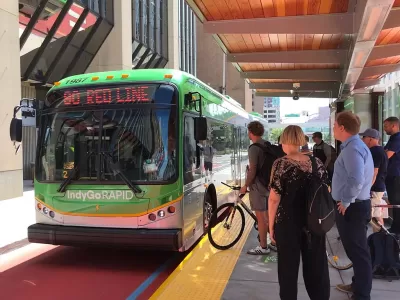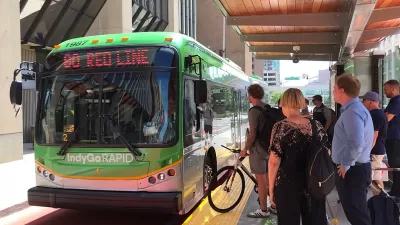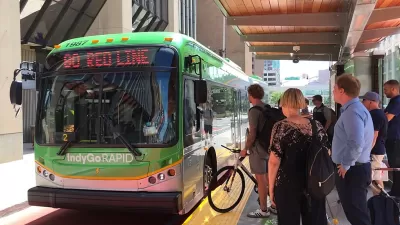The IndyGo transit system is wrapping up a period of free fares for its new Red Line bus rapid transit line before another big launch scheduled for spring 2020.

Kellie Hwang reports on the ridership figures from the first month of operation on the IndyGo Red Line bus rapid transit line in Indianapolis.
Ridership on the IndyGo Red Line surpassed 230,000 in the first month of Indianapolis' new rapid transit bus service.
IndyGo last week reported 230,651 boardings in September, or an average of nearly 7,700 per day. Total bus ridership systemwide was up 30%.
The Red Line has been free to ride since it launched Sept. 1. Nov. 11 is the planned date for tickets to be required, which is expected to affect ridership.
Despite that expected initial effect when fares are no longer free, IndyGo planners have more good transit news on the way in the spring, when the Marion County Transit Plan will roll out improved bus frequencies, longer hours of operation, and easier transfers.
All these improvements are made possible by a dedicated income tax supported by voters in 2016, before a delay and then approval by the City-County Council. Initial investments in the IndyGo bus system, made possible by the new tax revenue, also proved beneficial to bus ridership in 2018.
FULL STORY: Red Line ridership numbers for September are in. Here's how many are riding.

Trump Administration Could Effectively End Housing Voucher Program
Federal officials are eyeing major cuts to the Section 8 program that helps millions of low-income households pay rent.

Planetizen Federal Action Tracker
A weekly monitor of how Trump’s orders and actions are impacting planners and planning in America.

Ken Jennings Launches Transit Web Series
The Jeopardy champ wants you to ride public transit.

Philadelphia Is Expanding its Network of Roundabouts
Roundabouts are widely shown to decrease traffic speed, reduce congestion, and improve efficiency.

Why Bike Lanes Are Good: An Explainer for the US Transportation Secretary
Sean Duffy says there’s no evidence that bike lanes have benefits. Streetsblog — and federal agencies’ own data — beg to differ.

California Invests Additional $5M in Electric School Buses
The state wants to electrify all of its school bus fleets by 2035.
Urban Design for Planners 1: Software Tools
This six-course series explores essential urban design concepts using open source software and equips planners with the tools they need to participate fully in the urban design process.
Planning for Universal Design
Learn the tools for implementing Universal Design in planning regulations.
Ada County Highway District
Clanton & Associates, Inc.
Jessamine County Fiscal Court
Institute for Housing and Urban Development Studies (IHS)
City of Grandview
Harvard GSD Executive Education
Toledo-Lucas County Plan Commissions
Salt Lake City
NYU Wagner Graduate School of Public Service




























